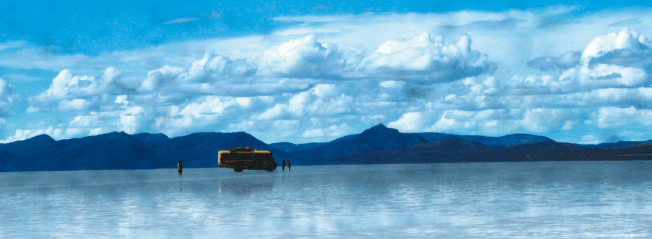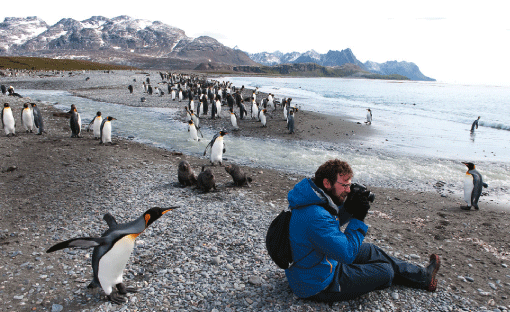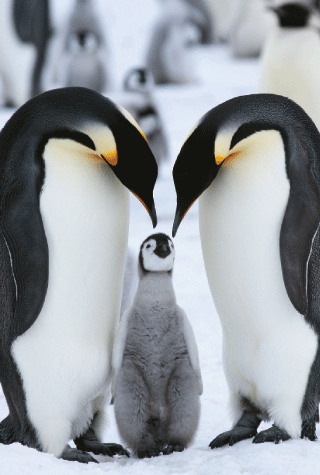
Bus2Antarctica
 |
I forget which birthday it was, but I do remember that I wished for Antarctica when I blew out the candles on my cake. Impossible dreams make good birthday wishes, and I used mine silently hoping that somehow, someday, I would make it to Earth's frozen continent.
Written & Photographs by: Andrew Evans
I had wanted to travel to Antarctica ever since I learned such a place existed. I craved the haphazard polar voyages of men before the era of airplanes and travel brochures. Those early travelers seemed so sincere as they set off for the bottom of the world with their optimism, simple dogsleds, and year's supply of stationery.
In pursuit of my dream, I auditioned for scientific internships on research ships and applied for menial jobs on American polar bases. I wrote elaborate proposals for special grants that were never granted and made wild attempts to win Internet contests. None of those efforts bore fruit.
So I decided to just go. I traced an imaginary path on a map, from Washington, D.C., where I live, down to the seventh continent. Where there's a road there's a way, I figured, and much of the distance to Antarctica was paved with roads. All I had to do was head south some 10,000 miles until the road ended in Tierra del Fuego. From there it was less than a knuckle's width of mapped sea to Antarctica. The catch was to figure out an affordable way to travel. My research revealed there were public buses in every country I'd pass through to the frozen continent. If I made no reservations and had no daily itinerary, bus travel would approximate the journeys of early explorers. For the spots of water I'd cross – the Strait of Magellan and the Drake Passage – it looked like I'd have to forsake bus for boat.
I eagerly mapped out a rough 10-week plan, arranged to post entries to Traveler's blog from the road, bought my first bus ticket – and embarked on my one-man polar expedition from a sidewalk bus stop outside National Geographic's headquarters in Washington, D.C.
It was New Year's Day, and all I carried was a backpack stuffed with clothes, a camera, and a new National Geographic flag. I paid $1.35 to ride the S2 Metro bus down 16th Street past the White House. An hour later I boarded a Greyhound bus to Atlanta, nervously anticipating the long road ahead. The bus driver took my ticket and asked routinely, "Your final destination, Sir?"
"Antarctica," I mumbled.
Greyhound wouldn't get me all the way there, but it could take me at least a thousand miles closer to my dream.
After three days of riding silver buses across the American South I found myself at a roadside rest stop in northern Mexico at midnight. While the other bus passengers slept, I ventured out into the cold, dry air and stretched my legs, kicking holes in the dust while the bus driver had a smoke. Aside from the glowing tip of his cigarette and some vague white stars, the only light flickered from a pile of orange embers on the ground, where a lone Indian woman wearing a red wool cap squatted and shaped tortillas, pat-pat-pat. I felt overwhelmed by the obscure scene and the utter darkness. I'd been to Mexico before, but not like this. The bus had delivered me to an invisible part of the world.
I hopped from one bus to the next over the coming days, grabbing any seat that was going south. In Guatemala, my ride was a reincarnated Blue Bird school bus painted with a rainbow of trim and with unhappy chickens wedged beneath the seats. A bus attendant hung from the open door with one hand and announced the destination, Huehuetenango, by shouting "Hue, Hue!" to everyone waiting. Any spot where a person stood waving became a bus stop. A hundred heads bobbed in time with the road. When the bus cruised around mountain turns, our jam-packed bodies slid from side to side. Audio speakers blared a sound track for the jungle landscape, but the CD skipped every time we hit a bump, turning sappy Latin love songs into thumping Spanish rap and back again.
After Guatemala's hairpin-turn highways, the bus careening along the edge of every mountain, we trailed through El Salvador's smoky backyards and the hacienda-feeling countryside of Honduras. The giant volcano hovering in the distance marked Nicaragua. In Costa Rica, the road became all twisty and pimpled with gaping potholes. We crossed into Panama, then over its famous canal on the mile-long Bridge of the Americas. The next hurdle was the geographical difficulty between Panama and Colombia known as the Darien Gap, a swath of jungle and swamp that forms a tricky hundred-mile interruption in the Pan-American Highway. My options around it: boat or plane.
Taking a tip from noted adventurer Paul Theroux, who for his best-selling book "The Old Patagonian Express" chose a plane ride, I flew to Cartagena, Colombia. There I boarded the next bus and within hours was traveling through the beautiful, and steep, Colombian Andes. These eventually gave way to Ecuador's endless green banana fields. Then came a jungle road in Peru that turned into a desert track; I tasted the dust on my teeth. Bus by bus I motored on into Bolivia, where, halfway across, the road vanished; the bus just followed tire tracks across the stratospherically high Uyuni plain.
Asphalt, smooth asphalt, returned in Argentina. Eager to catch my boat across the Drake Passage to Antarctica, I raced down these last 3,000 miles – the length of Argentina – in just seven days, watching the landscape transition from Cordoba's flat green pampa to Patagonia's dry brown hills, to the snow-sifted mountains of Tierra del Fuego (where we detoured briefly into Chile). The air cooled as we proceeded, and I noticed the austral sun setting later and later.
When nights came, I tried to sleep by folding my six-foot-four body into a bus seat and dreaming of Antarctica. One night, somewhere in Colombia, I was awakened by a loud crash, followed by our bus rumbling off the road. Nobody risked stepping out to see what happened, fearing bandits. I finally got off with the driver – and we discovered the cow our bus had hit and killed. As the sole passenger with a camera, I was enlisted to help document the carnage for the police.
Ironically, accidents and breakdowns offered new opportunities for discovery. Cruising at 12,000 feet along the Peruvian Andes, I'd just noticed that my inflatable neck pillow had sprung a leak when the wheels on the bus went pop, pop, pop. The flat tires occupied our driver for hours, which I spent taking walks across the rock-strewn altiplano, gazing up at the bluest skies I've ever seen. Passenger participation was mandatory in Bolivia. Each time we got stuck in mud – a regular occurrence – the bus driver would fling open the door and motion out our mix of bleary-eyed backpackers and gold-toothed Aymara Indians. Together we built piles of rocks behind each tire, then put shoulder to bumper and heaved. When we finally dislodged the bus, we sloshed through puddles to reboard.
Still, I can't think of a greater disappointment than rushing a first visit to Bolivia; it's like taking a kid to Disney World for the first time and telling him it closes in 10 minutes – forever. During my week traveling through it, Bolivia delivered some of the most memorable landscapes on a journey through remarkable places. The town of Uyuni, in southwestern Bolivia, for example, gives its name to the largest salt flat on Earth, which occupies a vast, dried-up prehistoric lake.
At 4,000 square miles, 40 times larger than the Bonneville Salt Flats in Utah, Uyuni's arid salt flat gives the odd sensation of standing on a blank piece of paper – a wide-open feeling of nothingness that attracts thousands of sightseers yearly. The surprise upon our arrival was that heavy seasonal rains had turned the salt flat into a saltwater flat. I found myself walking through six inches of lukewarm brine that crystallized up my leg on contact. Equally curious was the extraordinary way in which the sun reflected off the forever horizon of salt water – which burned my skin to a crisp.
Descending from high-altitude Bolivia into the desert hills of Argentina's Jujuy region proved another scenic highlight. Drab rock landscapes suddenly turned into pink-tinted rock formations, colored sandstone swirls, twisting mountain streams, and saguaro-like cacti. It felt as if we were driving through the arid reaches of southern Arizona – and it was HOT. How hot? My thermometer claimed the temperature was 48 degrees C. That's 118. Still, traveling in Argentina was a relief because everything was suddenly easy. Need a shower and nap before your next bus? There's a hotel with rooms for a few dollars an hour around the corner. Plus you can check your e-mail and recharge any batteries.
My last night, on the final bus, it snowed. I used the occasion to mark my progress with a Sharpie on a tattered map, amazed at the distance I'd covered on wheels. Finally, we rolled into a rainy parking lot in Ushuaia. This was it: the end of the road at the bottom of the continent. We stopped next to a dock for ships with reinforced hulls. On board one the next day I would spot my first icebergs.
Looking back now, I see my transcontinental ride as a road for which only I know the directions. My bus fare from Washington, D.C., to Antarctica? A total of $1,102.60 – about eleven cents a mile, half the price of a plane ticket for the same distance. The bus took longer, yes, but I got to see everything we miss out on when we choose to fly: The gradual changes from one place to another – and the real size of Earth. Before my trip, I only guessed at the planet's actual size. Now I've felt every inch of my 10,000-mile roller-coaster route in my lower back. I know the rhythm of so many landscapes from resting my forehead against countless bus windows.
On a bus, I can tell you, the world is measured in days. Earth is small – so much smaller than I once believed. Part of me wishes I could go back to the time when the planet felt huge and infinite. We accept intellectually that things don't become smaller, but secretly we may still wonder. Perhaps travel is the way we check our bearings, just to make sure. Are we getting bigger? Or is the world shrinking? What I do know is that my trip to Antarctica is no longer a dream. It's now a vivid memory.